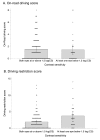Cross-sectional study assessing the addition of contrast sensitivity to visual acuity when testing for fitness to drive
- PMID: 29374663
- PMCID: PMC5829587
- DOI: 10.1136/bmjopen-2017-018546
Cross-sectional study assessing the addition of contrast sensitivity to visual acuity when testing for fitness to drive
Abstract
Objectives: The aim of this study is to quantify the importance of loss of contrast sensitivity (CS) and its relationship to loss of visual acuity (VA), driving restrictions and daytime, on-road driving evaluations in drivers aged 70+.
Design: A predictive cross-sectional study.
Setting: Volunteer participants to a drivers' refresher course for adults aged 70+ delivered by the Swiss Automobile Club in western Switzerland from 2011 to 2013.
Participants: 162 drivers, male and female, aged 70 years or older.
Clinical predictors: We used a vision screener to estimate VA and the The Mars Letter Contrast Sensitivity Test to test CS.
Outcomes: We asked drivers to report whether they found five driving restrictions useful for their condition; restrict driving to known roads, avoid driving on highways, avoid driving in the dark, avoid driving in dense traffic and avoid driving in fog. All participants also underwent a standardised on-road evaluation carried out by a driving instructor.
Results: Moderate to severe loss of CS for at least one eye was frequent (21.0% (95% CI 15.0% to 28.1%)) and often isolated from a loss of VA (11/162 cases had a VA ≥0.8 decimal and a CS of ≤1.5 log(CS); 6.8% (95% CI 3.4% to 11.8%)). Drivers were more likely (R2=0.116, P=0.004) to report a belief that self-imposed driving restrictions would be useful if they had reduced CS in at least one eye. Daytime evaluation of driving performance seems limited in its ability to correctly identify difficulties related to CS loss (VA: R2=0.004, P=0.454; CS: R2=0.006, P=0.332).
Conclusion: CS loss is common for older drivers. Screening CS and referring for cataract surgery even in the absence of VA loss could help maintain mobility. Reduced CS and moderate reduction of VA were both poor predictors of daytime on-road driving performances in this research study.
Keywords: ageing; automobile driving; contrast sensitivity; vision screening.
© Article author(s) (or their employer(s) unless otherwise stated in the text of the article) 2018. All rights reserved. No commercial use is permitted unless otherwise expressly granted.
Conflict of interest statement
Competing interests: None declared.
Figures


References
-
- Adler G, Rottunda S. Older adults' perspectives on driving cessation. J Aging Stud 2006;20:227–35. 10.1016/j.jaging.2005.09.003 - DOI
-
- Niemann S, Achermann Stürmer Y, Bianchi G, et al. . STATUS 2016: statistique des accidents non professionnels et du niveau de sécurité en Suisse; circulation routière, sport, habitat et loisirs. bpa 2016. 10.13100/bfu.2.275.02 - DOI
Publication types
MeSH terms
LinkOut - more resources
Full Text Sources
Other Literature Sources
Medical
Miscellaneous
